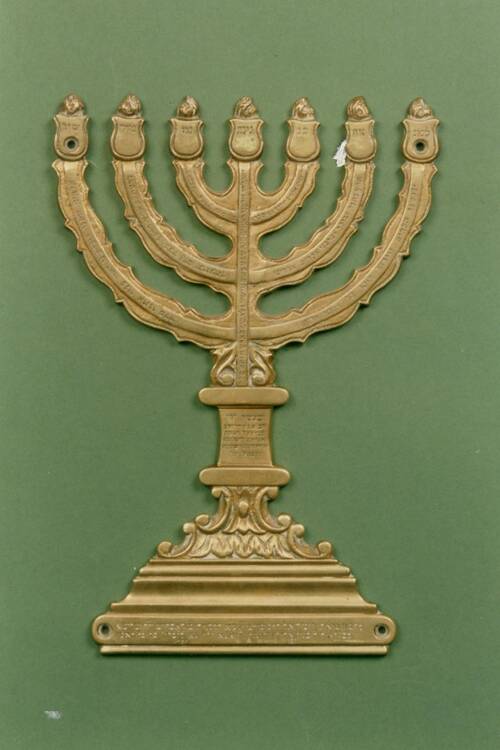Commemorating Kristallnacht: The Story of the last Chief Rabbi of Danzig
BY HANNAH SROUR
| Author | |
| Date Added |

Behind every item is a wealth of stories. As we commemorate the 83rd anniversary of Kristallnacht on November 9–10, and as part of ongoing commemorations for Holocaust Education Month in Canada, this week we’re telling the story of one such object in Shaar Hashomayim’s collection. It is an account of a beautiful menorah emblem and of the man who gifted it to the Shaar: Rabbi Dr. David Weiss (1876–1966), the last Chief Rabbi of Danzig, who escaped to Montreal shortly before the Nazis occupied Danzig in 1939. The menorah is reminder of the persecution Jews faced in the wake of Nazi terror, of the lost Jewish community of Danzig, and of a bond between it and our own community in Montreal.
This emblem, made of brass, was once displayed upon the rabbinical chair at the Danzig synagogue which Rabbi Weiss served. On the branches, Tehillim 67:2 is inscribed: “May God be gracious to us and bless us; may He cause His face to shine to us, Selah.” Along the stem is written: “Hand-crafted by the young man Avigdor and the young man Tzvi, for the sake of the soul of their upright father, Yehuda Leib ben Akiva Cleiman, of blessed memory.” And the following is written at the base: “A gift from Israel Lifshitz, 1883, for the sake of the Rebbetzin Mrs. Robris (1850) and Joseph Chaim, may he live a long life.”
Rabbi David Weiss

Photo courtesy of the Montreal Gazette (January, 21, 1966, p. 23)
Rabbi Dr. David Weiss was born in Galicia in 1875 or 1876, and studied at the Universities of Berlin and Bern. In 1920 he took up his first rabbinical post in Danzig. At the time, Danzig had the special status as a Free City following World War I. As a result, the city saw a mass influx of Jews from Eastern Europe seeking refuge. This greatly increased the Jewish population and intensified the need for more religious and rabbinic services. Prior to the War, under 3,000 Jews lived in Danzig; by 1923 there were over 7,000, reaching a peak of around 12,000 by 1937. As the strain of supporting this largely refugee Jewish community became too big for then-Chief Rabbi Dr. Robert Kaelter, Rabbi Weiss assumed much of the burden of his work. During his next years in Danzig, Rabbi Weiss operated primarily at the Orthodox New Synagogue in Langfuhr.

Clockwise from Right: (1) The Choir of the New Synagogue in Langfuhr, Danzig, 1928, photo ID 121591, courtesy of The Oster Visual Documentation Center, Beit Hatfutsot, courtesy of Abraham Sherman. (2) The rear exterior of the New Synagogue. (3) The front of the New Synagogue, courtesy of JewishGen
While the horrific pogrom of Kristallnacht largely took place on the 9th and 10th of November, 1938, Danzig was beset with anti-Jewish riots from the 12th to the 14th, during which four synagogues in the city were near-totally destroyed, including Rabbi Weiss’s New Synagogue (the building was later restored and as of 2007 has primarily operated as a music school, with some use by the Jewish community). The Jewish community of Danzig quickly organized itself and emigrated en masse. Many of the community’s Judaica and other memorabilia were rescued and brought to the Jewish Theological Seminary in New York in the summer of 1939. By the end of the year, merely 1,600 Jews remained. Rabbi Weiss was one of the last Jews to escape the city before the Nazi invasion; he delivered his final sermon to his congregation on May 25th, 1939 (the text of which is below). As he left, he saved one item from the synagogue: the emblem of a menorah which adorned the rabbi’s chair.
Rabbi Weiss in Montreal
Rabbi David Weiss arrived in Montreal in 1939, via St. Albans, Vermont. While he never took another pulpit position, he continued his humanitarian and aid work until his retirement at age 85, working as a hospital chaplain for the Baron de Hirsch Institute and as part of the Jewish Chaplains’ Service of the Montreal Federation of Jewish Community Services. Though he learned little English or French in his time here, he faithfully served the European Jewish immigrant community, many of whom still could not speak the local languages.
He passed away on January 18th, 1966. His obituary, which ran the following month in the Canadian Jewish Review, reads:
“Rabbi Weiss had always had an interest in all those requiring solace, encouragement, and help, whether they were orphans, hospital patients, or prisoners. At the age of sixty-five years, when others think of retiring, he embarked on a new voluntary career of visiting systematically the Montreal hospitals providing a service not existing at that time. In fair and foul weather, Dr. Weiss would travel throughout the city and went as far as the Military Hospital in Ste. Anne de Bellevue to visit the sick.”
Rabbi Weiss is buried next to his wife Hortense, who predeceased him on March 23rd, 1960, in the Shaar Hashomayim Cemetery on Mount Royal.
READ RABBI DAVID WEISS' SERMON
Other Sources
Monday, October 20, 2025
28 Tishrei 5786
OTHER ARTICLES
Telephone
514.937.9471
Fax
514.937.2067
admin@theshaar.org
Privacy Settings | Privacy Policy | Member Terms
©2025 All rights reserved. Find out more about ShulCloud
